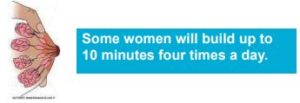Download and print as a PDF (788kB pdf)
On this page
What is this information about?
Antenatal Hand Expressing: a leaflet to inform mothers who would like to do antenatal hand expression of breast milk, from 36 weeks of pregnancy.
At the Brighton and Sussex University Hospitals Trust, we are working towards the Baby Friendly Initiative Global award. An important part of this work involves showing mothers the skill of hand expressing breast milk.
Antenatal hand expression is not new and dates back to medieval times. Over the last few years more and more trusts have been revisiting this age old skill to support infant feeding.
Why is hand expressing breast milk in pregnancy helpful?
- It may increase your awareness of how your breasts work
- It may increase your confidence in your ability to produce milk and breastfeed
- Colostrum collection (where this is possible) enables you to give colostrum to your baby in preference to manufactured milks, when there are early challenges
- Colostrum collection enables the prevention or treatment of hypoglycaemic (low blood sugar) episodes in at risk babies (breast milk achieves and maintains blood sugars, more efficiently than manufactured milks)
- Supports exclusive breastfeeding
- Avoids or reduces risk associated with manufactured milks
- Colostrum is rich in nutrients and antibodies that help to protect your baby from infection
How to hand express your breast milk?
- Applying some warmth to the breast before expressing may help (hot flannels or a shower)
- Wash hands before starting
- Collect with 1-2 ml oral syringes or when expressing larger quantities, a clean and sterilised container can be used Syringes and stoppers can be obtained from your community midwife
- Take your time, relax and think about your lovely bump and how pleased your baby will be to meet and be cuddled by you
- Cup the breast using your thumb and index finger in a ‘C’ shape, about 2.5 cms away from the base of the nipple.
- Compress your finger and thumb together, this should not hurt
- Relax and repeat the action, developing a rhythm
- Avoid sliding your fingers over the skin, dragging the skin, or pinching the nipple
- You may not see any colostrum, you may see a few drops; some women will produce a lot
- Volumes seem to increase with repeated expressions
- After a few minutes or after the flow of milk has stopped, rotate finger and thumb around and express again (thinking of the numbers on a clock and expressing on all the numbers can be helpful)
- Move to the other breast when rotation fails to bring a new flow of milk
- Just one hand expression a day is sufficient to practice the technique, but you can do more

Things to be aware of:
You may experience mild tightenings (your uterus going hard and then relaxing when you express). This is called Braxton Hicks and is nothing to worry about.
If it starts to feel like period pains or a mild contraction then stop hand expressing. This is very unusual but if you think that you could be in early labour then ring the labour ward.
How to store your expressed milk?
Your syringes can be labelled with your name, date of birth and date/time of collection. When collecting colostrum, you can build up to expressing a few times each day. Keep the syringe in the fridge between expressing sessions and use a fresh syringe each day and freeze it immediately. Syringes can be put into a box or bag together. If you do not have a freezer it can be stored in the fridge between 2 to 4 degrees Celsius for up to 5 days.
Transporting your expressed colostrum
- It is best to freeze your colostrum as you collect it at home and bring it into hospital at the time it is needed
- Use a cool bag with an ice pack for transporting it into hospital and ask a midwife to put it in the designated freezer as soon as possible on arrival
- Frozen colostrum must be used within 12 hours of thawing so to avoid wasting colostrum that has thawed but not been used, it is best to only bring a few syringes at a time
Further sources of information and advice
- If you have any more questions about antenatal hand expessing, please speak to your community midwife or phone the hospital on telephone 01444 441881 (Princes Royal Hospital) or telephone 01273 696955 (Royal Sussex County Hospital) and ask for the maternity day assessment unit
- The Breastfeeding Network: Expressing and storing breastmilk
Sources used for the information here
- National Institute for Health and Clinical Excellence, CG63 ‘Diabetes in pregnancy: management of diabetes’, March 2015
- Breastfeeding Review, ‘Expressing and storing colostrum antenatally for use in the newborn period’, 2006
- Journal of Diabetes Nursing, ‘Colostrum harvesting and type 1 diabetes’, 2005
- Expressing your milk antenatally. Sandwell and West Birmingham Hospitals NHS Trust. 2014
- Expressing milk before birth: A tool for use in special circumstances. Breastfeeding USA. 2014
- Effect of antenatal expression of breast milk at term to improve lactational performance: a prospective study. The Journal of Obstetrics and Gynaecology of India, vol. 59.No 4: July/August 2009
- How to teach a mother the technique of hand expressing. Midwives magazine: Issue 5: 2011
This information is for guidance purposes only and is in no way intended to replace professional clinical advice by a qualified practitioner.
This article is intended for patients receiving care in Brighton & Hove or Haywards Heath.